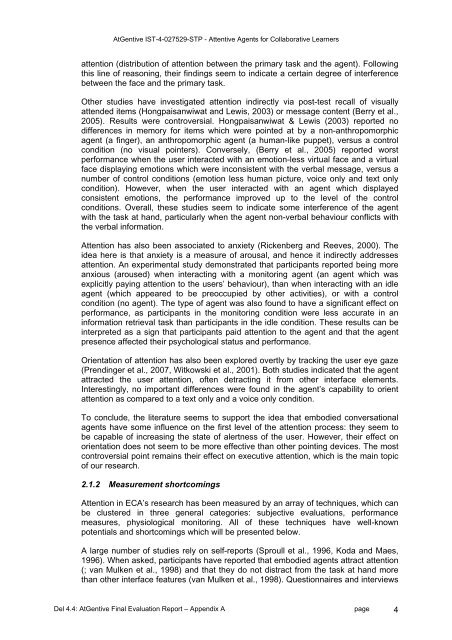Deliverable 4.4 - INSEAD CALT
Deliverable 4.4 - INSEAD CALT
Deliverable 4.4 - INSEAD CALT
You also want an ePaper? Increase the reach of your titles
YUMPU automatically turns print PDFs into web optimized ePapers that Google loves.
AtGentive IST-4-027529-STP - Attentive Agents for Collaborative Learnersattention (distribution of attention between the primary task and the agent). Followingthis line of reasoning, their findings seem to indicate a certain degree of interferencebetween the face and the primary task.Other studies have investigated attention indirectly via post-test recall of visuallyattended items (Hongpaisanwiwat and Lewis, 2003) or message content (Berry et al.,2005). Results were controversial. Hongpaisanwiwat & Lewis (2003) reported nodifferences in memory for items which were pointed at by a non-anthropomorphicagent (a finger), an anthropomorphic agent (a human-like puppet), versus a controlcondition (no visual pointers). Conversely, (Berry et al., 2005) reported worstperformance when the user interacted with an emotion-less virtual face and a virtualface displaying emotions which were inconsistent with the verbal message, versus anumber of control conditions (emotion less human picture, voice only and text onlycondition). However, when the user interacted with an agent which displayedconsistent emotions, the performance improved up to the level of the controlconditions. Overall, these studies seem to indicate some interference of the agentwith the task at hand, particularly when the agent non-verbal behaviour conflicts withthe verbal information.Attention has also been associated to anxiety (Rickenberg and Reeves, 2000). Theidea here is that anxiety is a measure of arousal, and hence it indirectly addressesattention. An experimental study demonstrated that participants reported being moreanxious (aroused) when interacting with a monitoring agent (an agent which wasexplicitly paying attention to the users’ behaviour), than when interacting with an idleagent (which appeared to be preoccupied by other activities), or with a controlcondition (no agent). The type of agent was also found to have a significant effect onperformance, as participants in the monitoring condition were less accurate in aninformation retrieval task than participants in the idle condition. These results can beinterpreted as a sign that participants paid attention to the agent and that the agentpresence affected their psychological status and performance.Orientation of attention has also been explored overtly by tracking the user eye gaze(Prendinger et al., 2007, Witkowski et al., 2001). Both studies indicated that the agentattracted the user attention, often detracting it from other interface elements.Interestingly, no important differences were found in the agent’s capability to orientattention as compared to a text only and a voice only condition.To conclude, the literature seems to support the idea that embodied conversationalagents have some influence on the first level of the attention process: they seem tobe capable of increasing the state of alertness of the user. However, their effect onorientation does not seem to be more effective than other pointing devices. The mostcontroversial point remains their effect on executive attention, which is the main topicof our research.2.1.2 Measurement shortcomingsAttention in ECA’s research has been measured by an array of techniques, which canbe clustered in three general categories: subjective evaluations, performancemeasures, physiological monitoring. All of these techniques have well-knownpotentials and shortcomings which will be presented below.A large number of studies rely on self-reports (Sproull et al., 1996, Koda and Maes,1996). When asked, participants have reported that embodied agents attract attention(; van Mulken et al., 1998) and that they do not distract from the task at hand morethan other interface features (van Mulken et al., 1998). Questionnaires and interviewsDel <strong>4.4</strong>: AtGentive Final Evaluation Report – Appendix A page 4
















